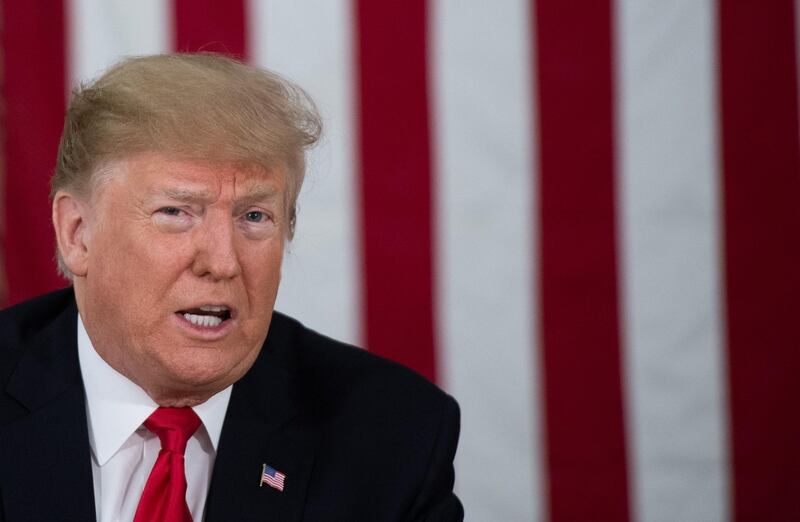When Donald Trump described Syria last week as a place of "sand and death", without "vast wealth", it would have helped him to first check his remarks with a contemporary historian.
That person might have been able to tell the US president that during a significant period of the last century, as it still is today, Syria was the centrepiece of competition between leaders in the Levant and Egypt, so that whoever controlled the country could pretend to a degree of regional dominance.
As Patrick Seale wrote in his classic book The Struggle for Syria, the nation's "centrality derives from the fact that it lies at the heart of the Arab-Asian power system where, for good or ill, it affects every political relationship in the region". With Mr Trump saying that his aim in the Middle East is to contain Iran, it made no sense for him to describe Syria dismissively. Without a strategy towards Syria, it is unlikely the US will succeed in curbing Iran.
The Iranians well understood the strategic importance of saving the regime of Bashar Al Assad in 2011. Had Mr Al Assad been removed, Tehran would have lost its main ally in the Levant, bordering its primary regional foe, Israel. Hezbollah, effectively Iran's foreign legion, would have been denied strategic depth in a future conflict with the Israelis, even as the party risked isolation in Lebanon amidst a large number of Lebanese who oppose what would be a devastating war.
In many regards Iran’s leaders were not so different from leaders past, who grasped that power in the Middle East often derived from Syria. Faisal I of Iraq had served for a brief moment as king of Syria after the First World War, until the French removed him. To his Hashemite family, ruling over Damascus incarnated their ambition of establishing a wider Arab nation under their control. Faisal’s ousting from the Syrian capital is still regarded by many Arabs as the essential moment when western imperial powers undermined Arab nationalist aspirations.
In 1946, Faisal’s brother Abdullah, by then king of Transjordan, began moves of his own to expand his rule to Syria. In this he had British support, because Britain believed that a Greater Syria under the rule of its Hashemite allies would allow it to maintain its influence in the Levant. Yet the plan never came to fruition and Abdullah had to contend with an Arab world united against him, a principal opponent being Egypt.
In February 1958, Gamal Abdel Nasser had scored a major victory in bringing Egypt and Syria together in a United Arab Republic. In the wake of the Suez War of 1956, when Britain, France, and Israel had colluded in attacking Egypt, this represented the pinnacle of the Egyptian president’s regional ambitions. The union collapsed after a coup in Syria in 1961, a severe blow to Mr Nasser’s prestige but also a major retreat for him in the Levant, particularly at a time of hostility with Iraq’s leader, Abdel Karim Qassem.
If the United States is serious about containing Iran, it will take more than imposing sanctions on the country, as Mr Trump appears to believe. The Iranian leadership responds to its own assessments of the balance of power, and what it has seen of US actions in Syria will not have impressed it.
During Barack Obama’s time in the White House, Iran realised that the US president had no desire to dispose of Mr Al Assad, let alone to take action against the regime’s transgression of Washington’s red lines on the use of chemical weapons. Worse, Mr Obama soon appeared to embrace Iran’s interests in Syria. In an interview with the American journalist Jeffrey Goldberg, the president affirmed that Saudi Arabia and Iran had to find a way “to share the [Middle Eastern] neighbourhood and institute some sort of cold peace”. It was implicit in his remarks that ceding Syria to Iran was part of the equation in creating this new power balance.
Mr Trump has not adopted such an attitude, but what he has embraced is an incoherent alternative. The president wants to oppose Iran, but doesn’t want the United States to play a central role in this. His diffidence may be understandable in light of the mood at home against engaging in new regional wars, but it begs the question: if Iran represents a strategic threat, as the US has asserted, then does it make sense for Washington to take a hands-off attitude in thwarting it?
Mr Trump’s superficial knowledge of the Middle East, and much else beyond America’s borders, doesn’t help him understand why so many members of his administration and Congress recently counselled against withdrawing from Syria. But even a quick look at the past 70 years would show him that Syria is about much more than sand and death. And today it is the primary place where Iran’s regional ambitions must be checked, if such an intention is serious.
Michael Young is editor of Diwan, the blog of the Carnegie Middle East programme, in Beirut





